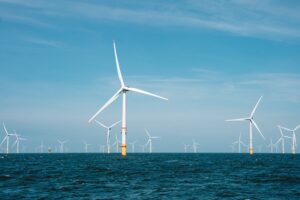As the United States continues to search for ways to reduce the nation’s reliance on oil and gas for energy, wind power has a key role to play.
Offshore wind farms, which place massive wind-powered turbines in coastal waters to generate energy from sea winds, are one of the primary avenues through which the U.S. is expanding its wind power capabilities.
There are several major offshore wind projects currently in the works that promise essentially infinite energy without the production of greenhouse gasses, but legal hurdles and technical challenges abound.
Current Major Offshore Wind Power Projects
According to a recent overview published by law firm Morgan Lewis, the U.S. has two major offshore wind projects competing to become the first to be fully operational for providing power to utility companies.
The first is the Vineyard Wind project, located off of Nantucket in Massachusetts.
Despite some permitting hiccups and a legal challenge from a group representing commercial fishermen, “there’s tangible progress being made on the state and country’s first commercial scale project,” Boston’s NPR affiliate, WBUR, reports.
According to the company behind the project, which is also named Vineyard Wind, the project is on track to begin producing energy by the end of 2023.
The second major project is New York State’s South Fork Wind project, which is being built in federal waters off the coast of Long Island.
The project will power 70,000 homes on Long Island, according to a statement from the town of East Hampton. Like Vineyard Wind, the South Fork Wind project is expected to be completed by the end of 2023.
Cost and Economic Impact of Developing Offshore Wind Power
Despite the potential environmental benefits that can come from utilizing offshore wind power, there are significant up-front investment costs that must be considered when advocating for these projects.
The primary components driving the high cost of investment in wind power include turbine procurement and installation, foundation construction, electrical infrastructure, substation establishment, and grid connection.
These expenses can vary significantly depending on the project’s scale, water depth, distance from shore, and regional factors. Generally, the initial capital outlay is higher for deeper waters and farther distances from the shore.
In addition to those up-front costs, investors interested in wind power must consider expenses related to maintaining offshore wind farms.
These operational costs include routine inspections, maintenance activities, repair and replacement of components, vessel operation, and workforce salaries.
While advancements in technology and improved operational practices have led to reduced operational costs, they still remain substantial — especially for projects in harsh marine environments.
Advances in Technology and the Future of Offshore Wind Farms
There are several major technological areas that call for continued development with an eye toward making offshore wind power cheaper, more efficient, and more powerful.
The first of these is the tech behind the turbines themselves. Advancements in turbine design such as increased rotor diameters and taller towers enable higher energy capture.
The use of advanced materials and aerodynamic enhancements also enhances turbine performance, allowing for increased energy production in varying wind conditions.
Floating turbine platforms are also gaining attention as they open up new possibilities for harnessing wind resources in deeper waters.
Another major area targeted by wind power researchers is power grid integration and transmission. For example, high-voltage direct current (HVDC) transmission systems are gaining popularity for their ability to efficiently transport large amounts of power over long distances, reducing transmission losses.
Advanced power electronics and grid management systems are also being developed and implemented to enhance the stability and reliability of offshore wind farms, and energy storage technologies, such as battery systems, are also evolving to provide grid stability and balance supply-demand fluctuations.
Lastly, new technology is being developed to better understand and address concerns regarding the impact of offshore wind farms on marine life.
Environmental monitoring tools, such as underwater acoustics and aerial surveys, are designed to aid in assessing and mitigating the effects of offshore wind farms on marine life. Collision detection systems and adaptive turbine designs are intended to help reduce the risk of bird and bat collisions.
Machine learning algorithms and data analytics are also being employed to optimize project siting, potentially reducing potential conflicts with sensitive habitats and maximizing energy yield.
The Big Challenge: Reviving America’s Outdated Power Infrastructure
One of the biggest challenges for wind power companies is the United States’ outdated and crumbling power grid system. This is a challenge not only for wind power advocates but for the entire renewable energy industry.
“Competition from renewables is being strangled without adequate and necessary upgrades to the transmission network,” Simon Mahan, executive director of the Southern Renewable Energy Association, which represents solar and wind companies, told Reuters last year.
A February 2023 report by the Department of Energy calls for “47,300 GW-mi of new transmission will be needed nationwide by 2035 to meet the scenario conditions of this group, a 57 percent growth in today’s transmission system,” adding that
Currently, there isn’t a plan to ensure this necessary infrastructure gets built.
According to Reuters, the dispersal of the “responsibility for grid maintenance, upgrades and inter-regional connections… among state and local regulators, utility companies and the seven grid operators” has resulted in a lack of central authority over the massive changes needed to expand access to wind power and other renewable energy.
Potential solutions to the problem vary, with the New York Times editorial board publishing arguments for deregulation and the Audubon Society calling on individuals to support policies that favor renewable energy and a reduction in fossil fuel subsidies.

